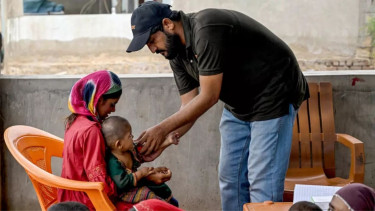12/16/2025

1.6m children at risk of acute malnutrition in 2025: IPC Report
ANM Mohibub Uz Zaman | Published: 2025-10-25 08:24:08

About 1.6 million Bangladeshi children aged between six and 59 months are suffering or expected to suffer from acute malnutrition in 2025, according to Bangladesh’s first IPC Acute Malnutrition (AMN) analysis.
Among them, 1,43,850 are projected to face severe acute malnutrition.
The report also estimates that around 1,17,000 pregnant and breastfeeding women will experience acute malnutrition during the same period.
The most affected areas include Bhola, Cox’s Bazar, Bagerhat, Sirajganj, Gaibandha, Kurigram and Bhashanchar, where food insecurity is more prevalent.
The IPC AMN analysis covered 18 districts across seven divisions, as well as Rohingya refugee populations in Cox’s Bazar and Bhashanchar.
For the January-April 2025 period, 11 districts – Barguna, Patuakhali, Pirojpur, Cox’s Bazar (host and refugee), Bagerhat, Satkhira, Jamalpur, Sherpur, Maulvibazar, Sunamganj and Sylhet – have been classified under IPC AMN Phase 3 (Serious).
The remaining seven – Bhola, Noakhali, Netrokona, Sirajganj, Gaibandha, Kurigram and Habiganj – are in Phase 2 (Alert). Among refugees, Cox’s Bazar is classified as Phase 3, and Bhashanchar is classified as Phase 2.
The report identifies multiple factors contributing to malnutrition among children and women, including inadequate food intake and low dietary diversity, with only half of children in some areas meeting the minimum dietary requirements; childhood illnesses such as diarrhoea, acute watery diarrhoea, and fever, which are widespread in Habiganj, Sunamganj, Sylhet and refugee camps in Cox’s Bazar; poor water, sanitation and hygiene (WASH) conditions, which expose children to frequent infections; acute food insecurity that restricts access to nutritious food; recurrent floods and cyclones, disrupting essential health, nutrition and WASH services.
Agro-economist and researcher Dr Jahangir Alam said that persistent inflation has made protein-rich foods unaffordable for many households.
“The prices of eggs, milk and meat are beyond consumers’ reach. Without adequate protein intake, people’s productivity declines and health deteriorates,” he said.
For the projected period (May-December 2025), the report warns of worsening malnutrition due to monsoon floods and cyclones, which are likely to increase diarrheal diseases and reduce access to food and healthcare.
Five areas currently under Phase 2 (Alert) – Kurigram, Gaibandha, Sirajganj, Bhola and Bhashanchar (refugees) – are expected to shift to Phase 3 (Serious). Most areas already in Phase 3 are projected to face further deterioration in the nutritional status of children and pregnant or breastfeeding women.
Experts suggest scaling up community-based management of acute malnutrition and Integrated Management of Childhood Illness within primary healthcare systems.
Promoting proper feeding and hygiene practices, along with multi-sectoral, nutrition-sensitive interventions, could help reverse the trend, particularly in the hardest-hit regions.
Editor & Publisher : Md. Motiur Rahman
Pritam-Zaman Tower, Level 03, Suite No: 401/A, 37/2 Bir Protik Gazi Dastagir Road, Purana Palton, Dhaka-1000
Cell : (+88) 01706 666 716, (+88) 01711 145 898, Phone: +88 02-41051180-81